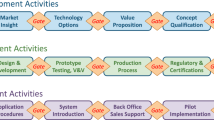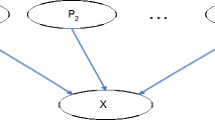Abstract
This paper proposes a cause-effect diagnostic method to aid in the identification of New Product Development (NPD) improvement opportunities, called the Diagile Method. The proposed method is based on the CRT method and incorporates best practices of project management and activities to identify relevant opportunities for improvement. Templates are provided to assist in each phase of the Diagile application and a tool is provided for conducting effective interviews with NPD personnel. The main Diagile outputs are a current reality tree and a personalized portfolio of NPD improvement projects. A controlled experiment involving two independent groups was performed to evaluate the method at a large multinational office supply manufacturer. The results of this research suggest several managerial implications for improving the NPD process. The first is that effective diagnosis plays an important role in improving the NPD process. A cause-effect diagnostic method enables a healthy discussion among multidisciplinary NPD teams seeking to improve NPD to make the right choice of NPD improvement projects. Finally, the company reported that Diagile has proved to be an excellent method to analyze the NPD process and identify its problems.
Access this chapter
Tax calculation will be finalised at checkout
Purchases are for personal use only
Preview
Unable to display preview. Download preview PDF.
Similar content being viewed by others
References
BUSHE, G. R., MARSHAK, R. J. Revisioning Organization Development: Diagnostic and Dialogic Premises and Patterns of Practice. The Journal of Applied Behavioral Science, 2009: 45(3), 348-368
CARBONARA, N., SCOZZI, B. Cognitive maps to analyze new product development processes: A case study. Technovation, 2006: 26(11), 1233-1243
CARRILLO, J. E., FRANZA, R. M. Investing in product development and production capabilities: The crucial linkage between time-to-market and ramp-up time. European Journal of Operational Research, 2006: 171, 536-556
Costa, J. M.H., Amaral, C. S. T., Rozenfeld, H. Systematization of Recurring NPD Problems: Opportunities and Challenges in Expediting Process Diagnosis. In: 15th International Product Development Management Conference, 2009, Twente.
DOGGETT, A.M. A Statistical Comparison of Three Root Cause Analysis Tools. Jounal of Industrial Technology, 2004: 20 (2)
DOGGETT, A.M. Root Cause Analysis: A Framework for Tool Selection. The Quality Management Journa. 2005: 12 (4)
FREDENDALL, L.D., PATTERSON, J.W., LENHARTZ, C., MITCHELL, B.C. What should be changed? Quality Progress 2002: 35 (1),50-59
GOLDRATT, E. M. It`s not luck. Great Barrington: North River Press:1994
Goodrich, D. F. The relationship of the theory of constraints implementation to change management integration in professional service organizations. Ph.D. thesis. School of Business and Entrepreneurship, New Southeastern University, 2008.
JESTON, J., NELIS, J. Business Process Management Practical Guidelines to Succesful Implementations. Oxford: Elsevier: 2008 (2o edition.)
MCCULLOCH, A., CRONSHAW, S.F. Reinstating the Lewinian vision: From force field analysis to organization field assessment. Organization Development Journal, 2008: 26(4), 89-103
ORTT, J. R., DUIN, P. A. The evolution of innovation management towards contextual innovation. European Journal of Innovation Management, 2008: 11(4), 522-538
RAHMAN, S. The theory of constraints`thinking process approach to developing strategies in supply chains. International Journal of Physical Distribuition & Logistics Management, 2002: 3(10), 809-828
VERNADAT, F. B. (1996). Enterprise Modeling and Integration: principles and applications. Springer
Acknowledgments
The authors are indebted to their GEI2 colleagues for their helpful suggestions, and to the Brazilian research funding agencies CNPq and CAPES for their financial support of this work.
Author information
Authors and Affiliations
Corresponding author
Editor information
Editors and Affiliations
Rights and permissions
Copyright information
© 2011 Springer-Verlag London Limited
About this paper
Cite this paper
Costa, J.M.H.d., Amaral, C.S.T., Rozenfeld, H. (2011). Proposal of a NPD Diagnostic Method to Identify Improvement Opportunities. In: Frey, D., Fukuda, S., Rock, G. (eds) Improving Complex Systems Today. Advanced Concurrent Engineering. Springer, London. https://doi.org/10.1007/978-0-85729-799-0_42
Download citation
DOI: https://doi.org/10.1007/978-0-85729-799-0_42
Published:
Publisher Name: Springer, London
Print ISBN: 978-0-85729-798-3
Online ISBN: 978-0-85729-799-0
eBook Packages: EngineeringEngineering (R0)




